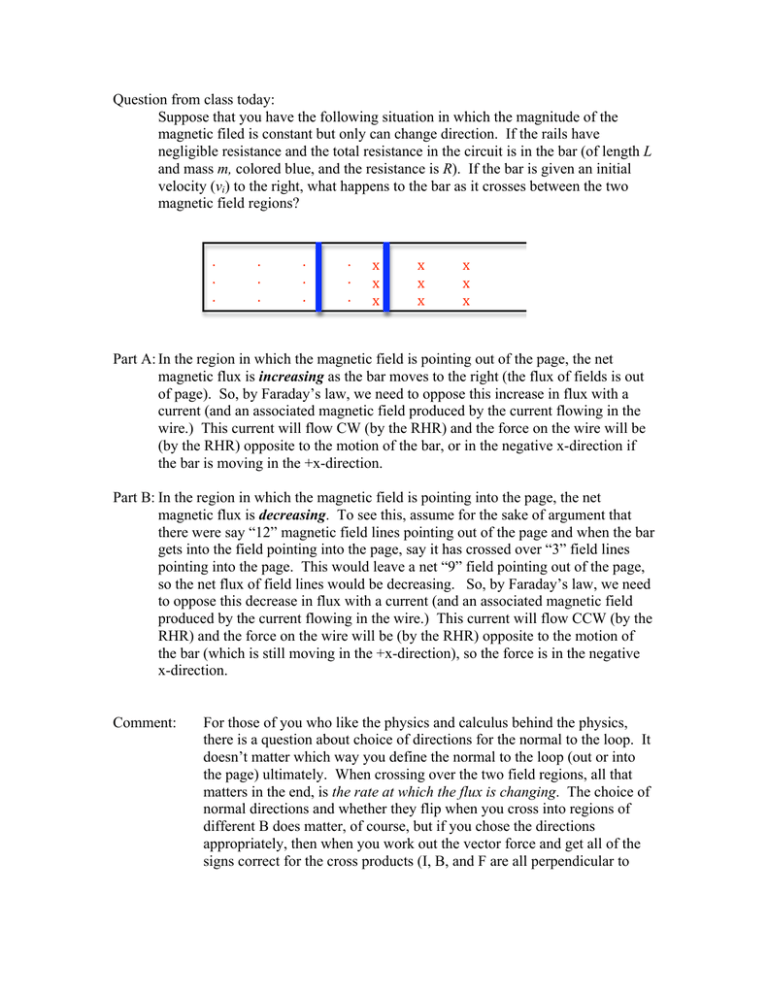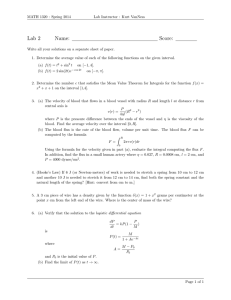here
advertisement

Question from class today: Suppose that you have the following situation in which the magnitude of the magnetic filed is constant but only can change direction. If the rails have negligible resistance and the total resistance in the circuit is in the bar (of length L and mass m, colored blue, and the resistance is R). If the bar is given an initial velocity (vi) to the right, what happens to the bar as it crosses between the two magnetic field regions? . . . . . . . . . . . . x x x x x x x x x Part A: In the region in which the magnetic field is pointing out of the page, the net magnetic flux is increasing as the bar moves to the right (the flux of fields is out of page). So, by Faraday’s law, we need to oppose this increase in flux with a current (and an associated magnetic field produced by the current flowing in the wire.) This current will flow CW (by the RHR) and the force on the wire will be (by the RHR) opposite to the motion of the bar, or in the negative x-direction if the bar is moving in the +x-direction. Part B: In the region in which the magnetic field is pointing into the page, the net magnetic flux is decreasing. To see this, assume for the sake of argument that there were say “12” magnetic field lines pointing out of the page and when the bar gets into the field pointing into the page, say it has crossed over “3” field lines pointing into the page. This would leave a net “9” field pointing out of the page, so the net flux of field lines would be decreasing. So, by Faraday’s law, we need to oppose this decrease in flux with a current (and an associated magnetic field produced by the current flowing in the wire.) This current will flow CCW (by the RHR) and the force on the wire will be (by the RHR) opposite to the motion of the bar (which is still moving in the +x-direction), so the force is in the negative x-direction. Comment: For those of you who like the physics and calculus behind the physics, there is a question about choice of directions for the normal to the loop. It doesn’t matter which way you define the normal to the loop (out or into the page) ultimately. When crossing over the two field regions, all that matters in the end, is the rate at which the flux is changing. The choice of normal directions and whether they flip when you cross into regions of different B does matter, of course, but if you chose the directions appropriately, then when you work out the vector force and get all of the signs correct for the cross products (I, B, and F are all perpendicular to each other remember, which is a cross product), the currents will still work out as above. As an added question, if you were still interested at this point, it would be natural to inquire, since there is a force, and by virtue of this force, the bar then would accelerate by Newton’s second law. If the bar accelerates then there is a change in the bar’s motion. What does the motion of the bar looks like? Part C: Could you model the motion of the bar? In other words, what is its velocity and displacement as functions of time? In what follows it doesn’t matter if the field switches direction or if the field remains in the same direction, the answers for the velocity, as a function of time and the trajectory (position of the bar as a function of time) will be the same. € € The magnitude of the force on the conducting bar is given by ε BLv vL2 B 2 . By Newton’s second law this force F = ILB = LB = IB = R R R produces a change in velocity given as: dv vL2 B 2 dv L2 B 2 F = ma = m =− → =− dt , where the negative is included since dt R v mR the force vector has to oppose the velocity vector. Suppose that the initial conditions are: initial velocity is vi, the final velocity vf, initial time = 0, and final time t. Thus we have vf v f v f dv L2 B 2 t L2 B 2 L2 B 2 = lnv − lnv = ln = − dt = − t → ln = − t ∫ v ∫ f i v mR mR v mR i i vi 0 ∴v f = v ie L2 B 2 − t mR So the velocity of the bar decreases exponentially with time. € From here, you could calculate the trajectory of the bar, by xf € t L2 B 2 − t mR L2 B 2 v i Rm − mR t dx = v e dt → x = − e . Thus the displacement is also ∫ ∫ i f 2 2 L B 0 0 exponential in time and if you let time go to infinity, the maximum distance v Rm covered by the bar is given by x max = i2 2 , which only depends on how fast you LB push the bar initially, given that the resistance, mass, length and magnetic field are constant. € So, the grand conclusion is that (I think) in the end, if the field switches direction it matters what the change in flux is and how it changes – does it increase or decrease. This dictates the current flow and when the bar crosses from the region in which the field switches direction the current changes direction and this produces a force that has to always oppose the motion of the bar.


